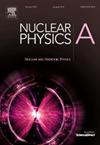慢准裂变抑制重离子聚变的观察
IF 2.5
4区 物理与天体物理
Q2 PHYSICS, NUCLEAR
引用次数: 0
摘要
核聚变形成超重元素的过程在概念上可分为俘获和复合核形成两个步骤。在捕获之后,如果两个原子核在形成平衡的复合原子核之前再分离,聚变就不能进行。这个结果叫做准分裂。在大多数情况下,准裂变和聚变-裂变分布有相当大的重叠。为了获得聚变的直接实验特征,蒸发残留物(ER)测量因此是复合核形成的最可靠的特征。采用16O、40Ar、48Ca、82Se和124sn诱导的[1]、[2]、[3]、[4]反应,形成相同的复合核的ER截面测量结果显示,相对于16O诱导的反应,[1]的融合受到了严重抑制。本文介绍了用28Si, 34S弹丸形成220的两个新反应的ER测量。这些测量结果最终表明,作为ZpZt的函数,ER截面呈指数抑制。裂变特性没有显示出质量角的相关性,这表明这里的ER截面受到慢准裂变的抑制。本文章由计算机程序翻译,如有差异,请以英文原文为准。
Observation of suppression of heavy-ion fusion by slow quasifission
The formation of superheavy elements (SHEs) by nuclear fusion can be conceptually divided into two steps: capture, and compound nucleus formation. Following capture, if the two nuclei reseparate before forming an equilibrated compound nucleus, fusion cannot proceed. This outcome is called quasifission.
In most cases, quasifission and fusion-fission distributions have considerable overlap. To obtain a direct experimental signature of fusion, evaporation residue (ER) measurements are therefore the most reliable signature of compound nucleus formation. ER cross section measurements forming the same compound nucleus, 220Th, using 16O, 40Ar, 48Ca, 82Se and 124Sn-induced reactions [1], [2], [3], [4] revealed [1] that fusion was severely suppressed for the more symmetric reactions relative to the 16O-induced reaction.
This work presents ER measurements of two new reactions forming 220Th using 28Si, 34S projectiles. These measurements conclusively show an exponential suppression of the ER cross section as a function of . The fission characteristics show no mass-angle correlation, demonstrating that here ER cross sections are suppressed by slow quasifission.
求助全文
通过发布文献求助,成功后即可免费获取论文全文。
去求助
来源期刊

Nuclear Physics A
物理-物理:核物理
CiteScore
3.60
自引率
7.10%
发文量
113
审稿时长
61 days
期刊介绍:
Nuclear Physics A focuses on the domain of nuclear and hadronic physics and includes the following subsections: Nuclear Structure and Dynamics; Intermediate and High Energy Heavy Ion Physics; Hadronic Physics; Electromagnetic and Weak Interactions; Nuclear Astrophysics. The emphasis is on original research papers. A number of carefully selected and reviewed conference proceedings are published as an integral part of the journal.
 求助内容:
求助内容: 应助结果提醒方式:
应助结果提醒方式:


